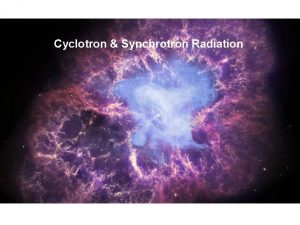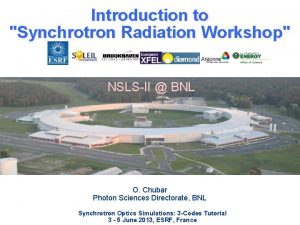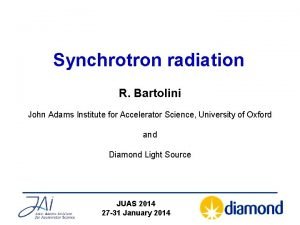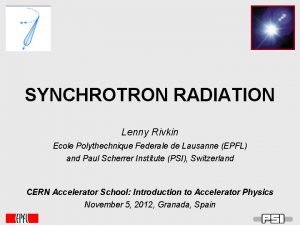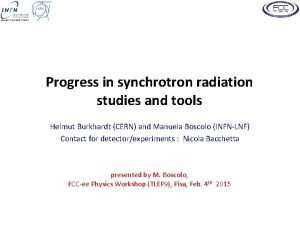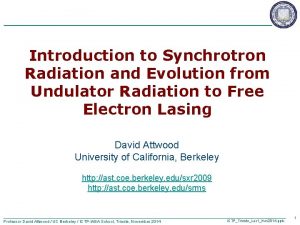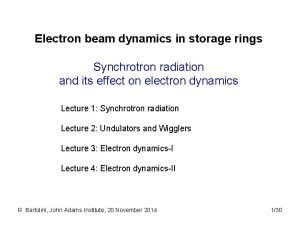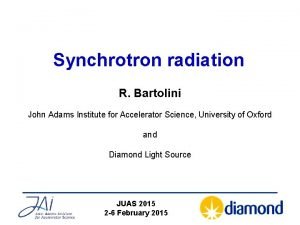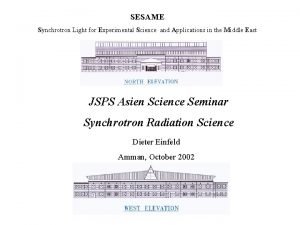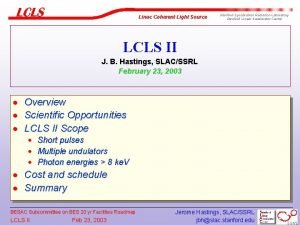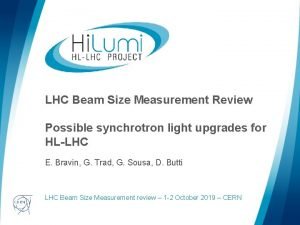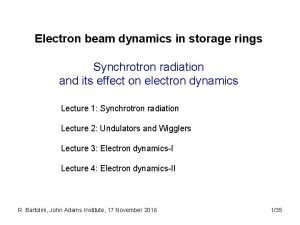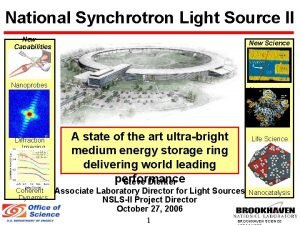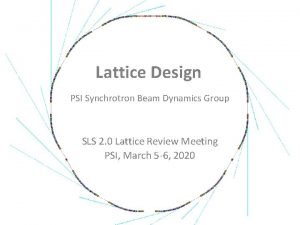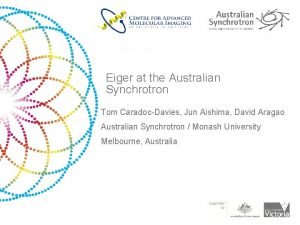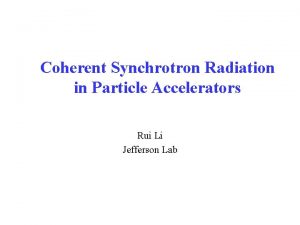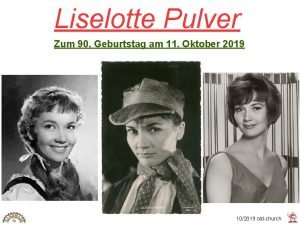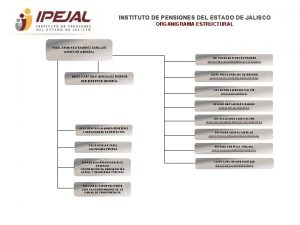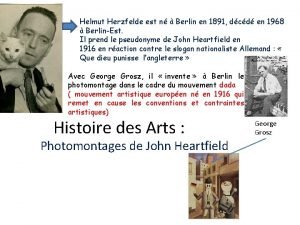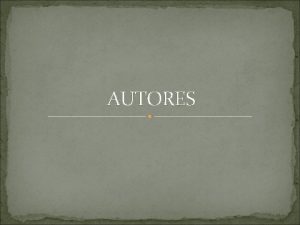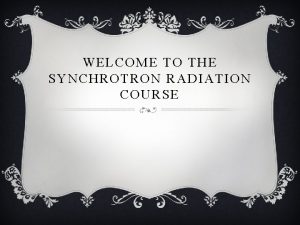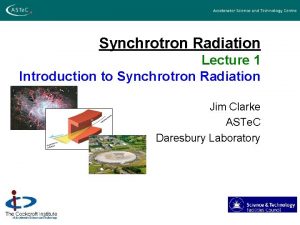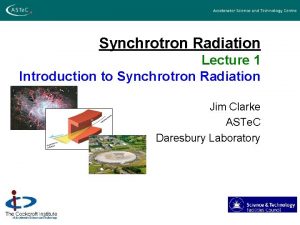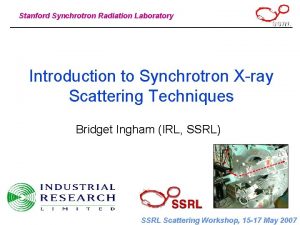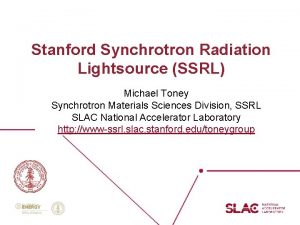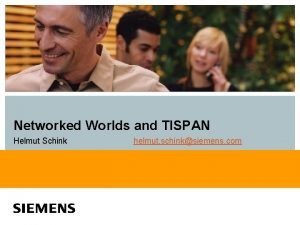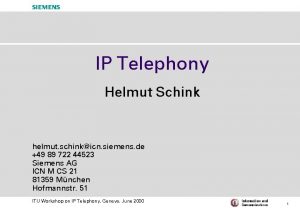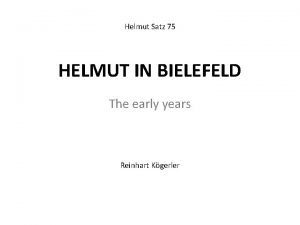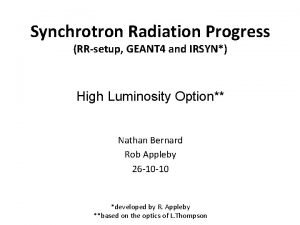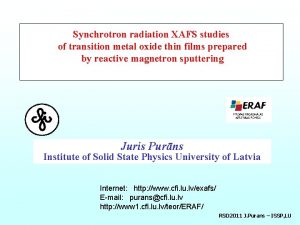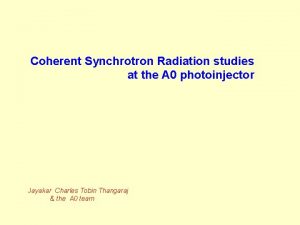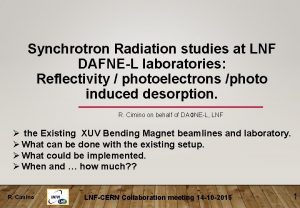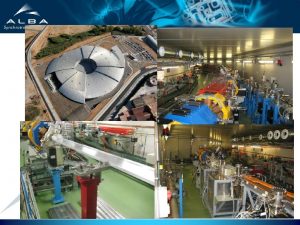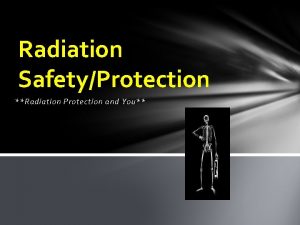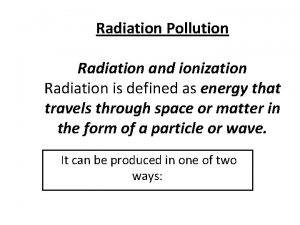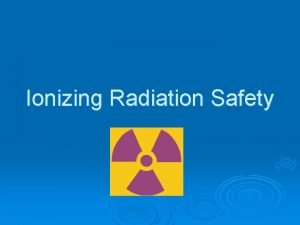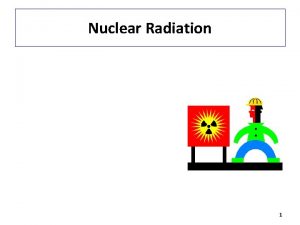Progress in synchrotron radiation studies and tools Helmut
























- Slides: 24

Progress in synchrotron radiation studies and tools Helmut Burkhardt (CERN) and Manuela Boscolo (INFN-LNF) Contact for detector/experiments : Nicola Bacchetta presented by M. Boscolo, FCC-ee Physics Workshop (TLEP 9), Pisa, Feb. 4 th 2015

Introduction • Synchrotron radiation fans in IR region for the BINP and CERN designs at top energy, 175 Ge. V / beam • More on MDI for FCC-ee, concepts and generic simulations : – – – Principles and scaling presentation by M. B. Experience with backgr. presentation by Helmut MDI for FCC-ee presentation by Nicola Losses in IR and Touschek presentation by M. B. IRChallenges presentation by Helmut Synchrotron Rad. in IR presentation by Helmut Oct. ’ 13 at TLEP#6 CERN March’ 14 at EIC’ 14 JLAB June ’ 14 at TLEP#7 CERN Oct. ’ 14 at HF 2014 Beijing Oct. ’ 14 at TLEP#8 Paris Dec. ‘ 14 at VIDYO meet. No. 11 CERN • Synchrotron Radiation is a big concern for FCC-ee, in addition there are other background sources that need careful studies

Background Sources Two Main Classes: – Synchrotron Radiation – beam particles e+, e-, e+e- effects • • • Bhabha Beamstrahlung Touschek beam-gas pair production …. Both aspects deeply studied for present/past machines – beam particles effects (better) studied at Factories – SR manageable extrapolation from LEP experience

Synchrotron Radiation mean free path length λ between radiation LEP 2, TLEP, B ≃ O ( 0. 1 T ) O(1 m) Syn. Rad cone distribution mostly from bending angle O( mrad ) + minor contribution from beam divergence O( 10 μrad) and Syn. Rad process angular distribution (at Ec) ~ 1/γ = 3 μrad @ TLEP 4

Spectrum Photon energy in units of the critical energy. x = Eγ / Ec For hom. field over formation length : single spectrum Geant 4 Test. Em 16 Photon spectrum weight with photon energy Power spectrum 10 Ge. V e+ moving initially in x-direction, bend downwards on a circular path by a 0. 1 T magnetic field in z-direction. Geant 4 Test. Em 16 This year : generalized to long live charged particle in Geant 4 10. 1 released 5/12/2014 Ref. : H. B. , CERN-OPEN-2007 -018, Geant 4 physics-manual Implemented as process G 4 Synchrotron. Radiation 5

Spectrum and absorption ✔ < 10 ke. V very difficult above 100 ke. V Typical mean (0. 3 Ec) photon energies B-factories (and FCC-hh) mostly below 10 ke. V LEP 1 : 21 ke. V LEP 2 : 320 ke. V (arc, last bend 10× lower) TLEP : ~ 350 ke. V ( arc, 175 Ge. V) -> very similar to LEP 2 difficult to collimate Enormous photon flux, MWs of power can get k. W locally, melt equipment, detectors. . Aim as for LEP 2 : do not generate hard synchrotron radiation anywhere close to the IR 6

Approach for FCC-ee IR challenges Challenge: maximize performance (integrated luminosity) for experiments for good or at least tolerable experimental (background, H. B. Chapter 5. 2 Landolt-Börnstein New Series I/21 C stability) conditions. γ spectrum Some key points : Minimize synchrotron radiation in the IR region => • Bends as weak as possible and as far as possible from IP • Quads have to be strong and close to IP, Minimize offset from quad axis Careful with vertical halo/tails γ-energy / Ecrit. SR Monte Carlo : H. B. CERN-OPEN-2007 -018 integrated in G 4 • For FCC the approach has been to start developing the software tools

SR from the final focusing magnets SR from the last vertical focusing magnet can usually be shielded from the IP detector beam pipe. This is more difficult when the photons penetrate the beam pipe SR from the last horizontal focusing magnet is more difficult to block because the beam is over-focused in order to compensate for the defocusing from the last quadrupole [M. Sullivan, HF 2014, Beijin, 9 -12 Oct. 2014] 8

MDISim: generic tool for IR studies • MAD-X lattice and survey (geometry), if available with apertures: basis • ROOT: main geometry and interface tool • With extra library to read MAD-X tfs files and calculate derived machine parameters (Syn. Rad) Step 1 : Construct tables (ntuples) with detailed information element by element transformation of Courant-Snyder machine coordinates to Euclidian detector coordinates

Display geometry and optionally accelerator tracks • Step 2 : geometry display based on MAD-X aperture information using the EVE (Event Visualization Environment) • Step 3 : accelerator tracking (several options, example here is MAD-X, LHC IR geometry) Run our demo : http: //hbu. web. cern. ch/hbu/Geom/my_Geom_Eve_Display. C root. x my_Geom_Eve_Display. C




TLEP Optics with Crab Waist - BINP (TLEP_V 14_IR_6 -13 -2) MDISIM output red color : energy over 100 ke. V, and within 200 m of IP bends iele 13 15 39 59 65 91 105 129 135 161 235 241 247 253 275 282 284 292 294 NAME KEYWORD m m L. MB 0 L. MB 1 L. MB 2 L. MB 3 L. MB 4 L. MB 5 L. MB 6 L. MB 7 L. MB 8 L. MB 9 L. MB 10 L. MB 11 L. MB 12 L. MB 13 MB 1. A 1 C 1. DS MB 2. A 1 C 1. DS MB 3. A 1 C 1. DS MB 4. A 1 C 1. DS MB 5. A 1 C 2. DS MB 6. A 1 C 2. DS S L Angle ke. V Emean ngam. Bend m T m rho mm B mrad BETX Watt SIGX divx Power SBEND 22. 56 10. 5 0. 001 348. 64 3. 6071 1. 05 e+04 0. 055594 122 0. 4646 0. 02834 3. 349 e+04 SBEND 33. 66 10. 5 0. 0037 1290 13. 346 2. 84 e+03 0. 205698 14. 21 0. 1586 0. 02834 4. 585 e+05 SBEND 73. 68 10. 5 0. 0037674 1313. 59 2. 79 e+03 0. 209446 78. 22 0. 372 0. 01655 4. 753 e+05 SBEND 107. 2 14. 5 0. 0051804 1307. 9 18. 686 2. 8 e+03 0. 208551 2. 024 0. 05984 0. 03686 6. 508 e+05 SBEND 123. 5 14. 5 0. 0051804 1307. 9 18. 686 2. 8 e+03 0. 208551 185. 1 0. 5723 0. 03686 6. 508 e+05 SBEND 179. 7 14. 5 0. 00063536 160. 41 2. 2918 2. 28 e+04 0. 025578 6. 146 0. 1043 0. 01713 9789 SBEND 221. 5 14. 5 0. 0002393 60. 415 0. 86319 6. 06 e+04 0. 00963366 84. 76 0. 3873 0. 005598 1389 SBEND 274. 6 14. 5 -0. 0031537 796. 19 11. 376 4. 6 e+03 -0. 126959 8. 549 0. 123 0. 01494 2. 412 e+05 SBEND 291 14. 5 -0. 0031537 796. 19 11. 376 4. 6 e+03 -0. 126959 26. 96 0. 2184 0. 01494 2. 412 e+05 SBEND 345. 5 14. 5 -0. 0028026 707. 57 10. 109 5. 17 e+03 -0. 112827 19. 14 0. 184 0. 01956 1. 905 e+05 SBEND 526. 5 10. 5 0. 0011018 384. 13 3. 9743 9. 53 e+03 0. 0612522 18. 23 0. 1796 0. 02132 4. 065 e+04 SBEND 543. 5 10. 5 0. 0011018 384. 13 3. 9743 9. 53 e+03 0. 0612522 23. 68 0. 2047 0. 01544 4. 065 e+04 SBEND 571. 8 10. 5 0. 0011018 384. 13 3. 9743 9. 53 e+03 0. 0612522 7. 454 0. 1148 0. 01544 4. 065 e+04 SBEND 588. 8 10. 5 0. 0011018 384. 13 3. 9743 9. 53 e+03 0. 0612522 86. 85 0. 392 0. 02132 4. 065 e+04 SBEND 686. 4 10. 5 0. 00048843 170. 29 1. 7618 2. 15 e+04 0. 0271539 35. 99 0. 2523 0. 01122 7989 SBEND 697. 5 10. 5 0. 00048843 170. 29 1. 7618 2. 15 e+04 0. 0271539 16. 97 0. 1733 0. 01122 7989 SBEND 711. 4 10. 5 0. 00048843 170. 29 1. 7618 2. 15 e+04 0. 0271539 36. 24 0. 2532 0. 01122 7989 SBEND 722. 5 10. 5 0. 00048843 170. 29 1. 7618 2. 15 e+04 0. 0271539 73. 12 0. 3597 0. 01122 7989 SBEND 736. 4 10. 5 0. 00048843 170. 29 1. 7618 2. 15 e+04 0. 0271539 35. 99 0. 2523 0. 01122 7989 SBEND 747. 5 10. 5 0. 00048843 170. 29 1. 7618 2. 15 e+04 0. 0271539 16. 97 0. 1733 0. 01122 7989 from summing up energy loss the 1660 bends U 0 sum=2. 149 Ge. V Pow. Sum= 57. 234 MW Quads, at 1 sigmax, horizontal iele Element s m 5 7 9 11 17 19 L. MQ 0_1 L. MQ 0_2 L. MQ 1_1 L. MQ 1_2 L. MQ 2_1 L. MQ 2_2 betx m 3. 8 5. 6 7 8 35. 7 36. 7 sigx divx K 1 L k 0 L x Angle Emean ngam Power mm mrad m-2 m-1 m mm ke. V Watt 41. 5 0. 2709 0. 006531 -0. 29142 7. 8947 e-05 1. 8 8. 6833 e-32 0. 000142104 289. 004 0. 512589 183 0. 5684 0. 003113 -0. 29142 0. 00016565 1. 8 1. 7717 e-31 0. 000298166 606. 395 1. 07553 393 0. 8338 0. 002122 0. 15977 0. 00013321 1 2. 5822 e-31 0. 000133211 487. 651 0. 480509 433 0. 8752 0. 002022 0. 15977 0. 00013984 1 2. 7024 e-31 0. 000139835 511. 902 0. 504405 7. 16 0. 1126 0. 01571 -0. 06095 6. 8626 e-06 1 5. 8903 e-20 6. 86259 e-06 25. 1222 0. 0247543 5. 8 0. 1013 0. 01747 -0. 06095 6. 1735 e-06 1 7. 0102 e-20 6. 17354 e-06 22. 5998 0. 0222688 3944. 81 17367. 2 6239. 69 6875. 72 16. 56 13. 4015 from summing up energy loss in the 1562 quads U 0 Sum=0. 00390576 Ge. V plane=x Pow. Sum=104. 006 k. W Optics files in /afs/cern. ch/eng/fcc/ee/TLEP_V 14_IR_6 -13 -2/ by Anton Bogomyagkov et al as presented by Anton and Dmitry last Dec. : https: //indico. cern. ch/event/356596/ 14

FCC-ee crab-waist IR A. Bogomyagkov

Syn. Rad bend cones TLEP_V 14_IR_6 -13 -2 BINP y MDISIM/root/ 3 d-OGL display x Looking at one beam, 0 - 500 m right of IR x, y scales × 100 B 4 -6 B 3 B 4 0. 1 m IP B 2 B 0 0 B 1 z 100 m 16

TLEP Optics - CERN (TLEP_V 12 A) MDISIM output red color : energy over 100 ke. V, and within 200 m of IP bends iele 14 24 26 36 39 49 51 61 79 81 88 90 98 100 107 109 119 121 130 132 NAME BMVC BMHC MB 1. A 3 C 1. DS MB 2. A 3 C 1. DS MB 3. A 3 C 1. DS MB 4. A 3 C 1. DS MB 5. A 3 C 2. DS MB 6. A 3 C 2. DS MB 7. A 3 C 2. DS MB 8. A 3 C 2. DS MB 9. A 3 C 3 MB 10. A 3 C 3 MB 11. A 3 C 3 MB 12. A 3 C 3 KEYWORD S L Angle Emean ngam. Bend rho B BETX SIGX divx Power m m ke. V m T m mm mrad Watt SBEND 129 47. 26 0. 002 154. 92 7. 2143 2. 36 e+04 0. 024704 315. 4 0. 5597 0. 005639 7368 SBEND 273. 8 47. 26 0. 002 154. 92 7. 2143 2. 36 e+04 0. 024704 101. 8 0. 318 0. 00564 7368 SBEND 322. 1 47. 26 0. 002 154. 92 7. 2143 2. 36 e+04 0. 024704 315. 4 0. 5597 0. 005639 7368 SBEND 466. 8 47. 26 0. 002 154. 92 7. 2143 2. 36 e+04 0. 024704 101. 8 0. 318 0. 00564 7368 SBEND 503 35. 19 -0. 002 208. 03 7. 2143 1. 76 e+04 -0. 0331727 21. 71 0. 1468 0. 006974 9893 SBEND 611. 6 35. 19 -0. 002 208. 03 7. 2143 1. 76 e+04 -0. 0331727 100. 1 0. 3153 0. 006973 9893 SBEND 647. 8 35. 19 -0. 002 208. 03 7. 2143 1. 76 e+04 -0. 0331727 21. 71 0. 1468 0. 006974 9893 SBEND 756. 4 35. 19 -0. 002 208. 03 7. 2143 1. 76 e+04 -0. 0331727 100. 1 0. 3153 0. 006973 9893 SBEND 808. 8 10. 5 0. 00049583 172. 87 1. 7885 2. 12 e+04 0. 0275653 36. 2 0. 1896 0. 008248 2038 SBEND 819. 9 10. 5 0. 00049583 172. 87 1. 7885 2. 12 e+04 0. 0275653 17. 59 0. 1322 0. 008248 2038 SBEND 833. 8 10. 5 0. 00049583 172. 87 1. 7885 2. 12 e+04 0. 0275653 36. 26 0. 1898 0. 008233 2038 SBEND 844. 9 10. 5 0. 00049583 172. 87 1. 7885 2. 12 e+04 0. 0275653 71. 82 0. 2671 0. 008233 2038 SBEND 858. 8 10. 5 0. 00049583 172. 87 1. 7885 2. 12 e+04 0. 0275653 35. 5 0. 1878 0. 008334 2038 SBEND 869. 9 10. 5 0. 00049583 172. 87 1. 7885 2. 12 e+04 0. 0275653 17. 04 0. 1301 0. 008334 2038 SBEND 883. 8 10. 5 0. 00049583 172. 87 1. 7885 2. 12 e+04 0. 0275653 36. 37 0. 19 0. 008385 2038 SBEND 894. 9 10. 5 0. 00049583 172. 87 1. 7885 2. 12 e+04 0. 0275653 73. 15 0. 2695 0. 008385 2038 SBEND 908. 8 10. 5 0. 00099166 345. 74 3. 5771 1. 06 e+04 0. 0551306 36. 11 0. 1894 0. 008386 8152 SBEND 919. 9 10. 5 0. 00099166 345. 74 3. 5771 1. 06 e+04 0. 0551306 17. 09 0. 1303 0. 008386 8152 SBEND 933. 8 10. 5 0. 00099166 345. 74 3. 5771 1. 06 e+04 0. 0551306 36. 29 0. 1898 0. 00838 8152 SBEND 944. 9 10. 5 0. 00099166 345. 74 3. 5771 1. 06 e+04 0. 0551306 72. 99 0. 2692 0. 00838 8152 from summing up energy loss the 6592 bends U 0 sum=7. 801 Ge. V Pow. Sum=51. 4238 MW Quads, at 1 sigmax, horizontal iele Element s betx sigx divx K 1 L k 0 L x Angle Emean ngam Power m m mm mrad m-2 m-1 m mm ke. V Watt 3 Q 4 3. 07 16. 7 0. 129 0. 007701 -0. 6072 7. 8304 e-05 1. 0741 3. 9205 e-21 8. 41039 e-05 286. 651 0. 303374 573. 256 5 Q 3 6. 31 127 0. 3545 0. 002801 0. 27506 9. 7521 e-05 1. 2351 1. 3913 e-20 0. 00012045 356. 999 0. 434479 1022. 47 8 Q 2 65. 4 28. 7 0. 1688 0. 005882 -0. 038944 6. 5752 e-06 1 2. 412 e-20 6. 5752 e-06 24. 0701 0. 0237176 3. 76329 10 Q 1 80. 8 101 0. 3168 0. 003135 0. 033179 1. 0511 e-05 1 4. 0143 e-20 1. 05115 e-05 38. 4799 0. 0379163 9. 61782 13 QDV 81. 8 102 0. 318 0. 003123 -0. 014755 4. 6918 e-06 0. 5 4. 0051 e-20 2. 34588 e-06 17. 1753 0. 00846191 0. 958055 15 QFV 2 130 312 0. 5568 0. 001784 0. 02951 1. 6431 e-05 1 5. 3019 e-18 1. 64308 e-05 60. 149 0. 0592681 23. 4999 19 QDV 2 178 8. 04 0. 08934 0. 01112 -0. 02951 2. 6363 e-06 1 8. 399 e-18 2. 63629 e-06 9. 65078 0. 00950944 0. 604971 23 QFV 2 227 315 0. 5597 0. 001774 0. 02951 1. 6517 e-05 1 2. 2837 e-17 1. 65167 e-05 60. 4635 0. 059578 23. 7463 25 QDV 2 275 102 0. 318 0. 003123 -0. 02951 9. 3835 e-06 1 1. 0464 e-17 9. 38351 e-06 34. 3507 0. 0338476 7. 66444 Pow. Sum=91. 4409 k. W Based on tlep_v 12 a_cern_full_ring. madx from Roman Martin received by email on 10/12/2014 17

Syn. Rad bend cones for CERN optics TLEP_V 12 A MDISIM/root/ 3 d-OGL display y x Looking at one beam, 0 - 500 m right of IR x, y scales × 100 IP BMVC, 129 m z BMVC 273. 8 m BMVC, 322 m BMVC, 467 m 1

Synchrotron Radiation Concerns: • compatibility of stay-clear apertures with effective masking of incoming SR • edge scattering from upstream SR masks • backscattering from downstream aperture limitations

Beam Particle Effects • Beam-gas • Touschek Machine Induced Backgrounds single beam effect, losses in the whole tunnel • Radiative Bhabha IP backgrounds, mainly losses at IP, multiturn tracking needed for low-angle scatterings • Beamstrahlung strongly dependent on momentum acceptance • e+e- pairs

Dependence on Energy Acceptance Beamsstrahlung rate (FCC-ee) Radiative Bhabha Cross-section (Super. B) s(rad. Bhabha) [mbarn] 350 300 [M. Zanetti] BBBREM f(x) 250 200 150 100 s * L = Bremsstrahlung rate 50 0 DE/E 0 0. 005 0. 015 0. 02 Touschek particles/ second Rate (Hz) Super. B LER (4 Ge. V; 1. 49 m. A 1 bunch) Super. B HER (7 Ge. V; 1. 49 m. A 1 bunch) DAFNE crabwaist (0. 51 Ge. V; 10 m. A 1 bunch) Lifetime estimated for these effects usually assumes ring’s energy acceptance DE/E

Momentum aperture A. Xiao, M. Borland, PAC 07 p. 3457 • Crucial for all sources inducing a d. E/E like Touschek, rad Bhabha, beamstralung (HE) • Best determined with full tracking d. E/E Loss probability momentum aperture LER Super. B Touschek Monte Carlo tracking s(m) IP Not just an s dependent momentum aperture PEP-X Y. Cai, SLAC FLS-2012, March 2012

Pair production: e+e- (and m+m-) • e+e- -> e+e- e+e • It can be studied with GUINEA-PIG generator • can be high production rate but particles have low energy and loop in the solenoid field • relevant for which sub-system? – typically low energy curling e+e- relevant for vertex detector and first layers of tracking devices • first guess at generator level (with magnetic fields) • full simulation with Geant 4 needed for detailed study • Same statements are valid for m+m- production (e+e- -> e+e- m+m-) to be checked at these energies

Conclusions • Synchrotron radiation in the IR region is a major issue for TLEP @ top energy • Photon energy very similar to LEP 2 where this was acceptable with IRs designed for low synrad + ~100 collimators and local masks, ( L ~ 1. e 32 cm-2 s-1 ) • Work for FCC-ee / TLEP only started --- much more to do on IR synchrotron radiation and beam particle effects 2
 Synchrotron radiation
Synchrotron radiation Felexit
Felexit Synchrotron radiation
Synchrotron radiation Synchrotron radiation
Synchrotron radiation Synchrotron
Synchrotron Synchrotron radiation
Synchrotron radiation Synchrotron radiation
Synchrotron radiation Photon density formula
Photon density formula Sesame synchrotron
Sesame synchrotron Synchrotron radiation
Synchrotron radiation Synchrotron
Synchrotron Synchrotron radiation
Synchrotron radiation Physical progress and financial progress
Physical progress and financial progress National synchrotron light source ii
National synchrotron light source ii Psi synchrotron
Psi synchrotron Synchrotron
Synchrotron Synchrotron
Synchrotron Curriculum progress tools
Curriculum progress tools Paradigm shift from women studies to gender studies
Paradigm shift from women studies to gender studies Helmut weldle
Helmut weldle Melisande schmid germaine pulver
Melisande schmid germaine pulver Enrique helmut meyer mercado
Enrique helmut meyer mercado Helmut herzfelde
Helmut herzfelde Helmut jungclaus
Helmut jungclaus Die hamletmaschine
Die hamletmaschine
